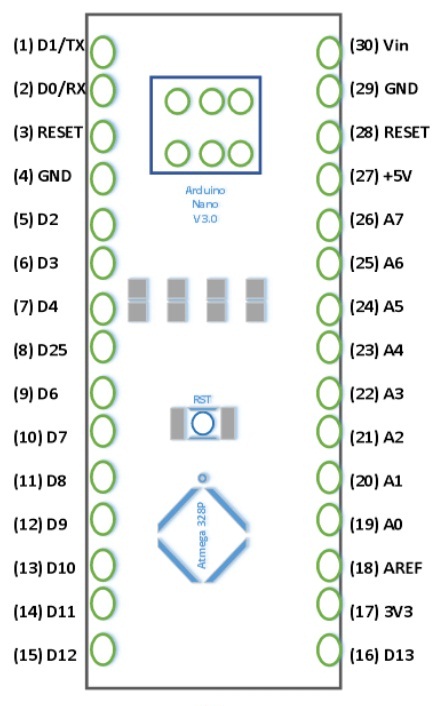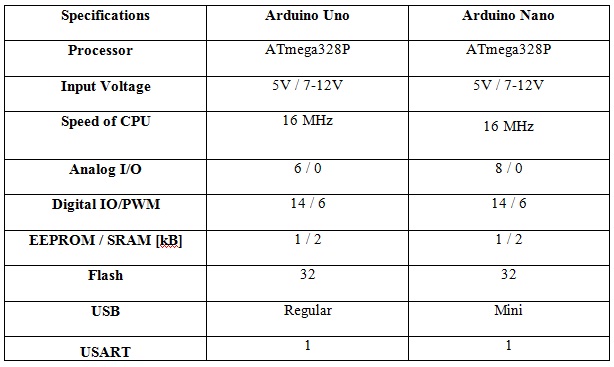An Overview of Arduino Nano Board
This article gives detailed information about an Arduino Nano board, and it is one kind of microcontroller board which is designed by the Arduino team. This microcontroller is based on Atmega168 or Atmega328p. It is fairly similar to Arduino Uno board but when it comes to pin-configuration and features, this nano board has replaced Arduino Uno due to small in size. As we know that while designing an embedded system small size components are preferred. Arduino boards are mainly used to build electronic projects. embedded systems, robotics, etc. But the nano boards are mainly introduced for the beginners who are not from the technical background.
What is an Arduino Nano Board?
Arduino Nano is one type of microcontroller board, and it is designed by Arduino.cc. It can be built with a microcontroller like Atmega328. This microcontroller is also used in Arduino UNO. It is a small size board and also flexible with a wide variety of applications. Other Arduino boards mainly include Arduino Mega, Arduino Pro Mini, Arduino UNO, Arduino YUN, Arduino Lilypad, Arduino Leonardo, and Arduino Due. And other development boards are AVR Development Board, PIC Development Board, Raspberry Pi, Intel Edison, MSP430 Launchpad, and ESP32 board.
This board has many functions and features like an Arduino Duemilanove board. However, this Nano board is different in packaging. It doesn’t have any DC jack so that the power supply can be given using a small USB port otherwise straightly connected to the pins like VCC GND. This board can be supplied with 6 to 20volts using a mini USB port on the board.
Arduino Nano Features
The features of an Arduino nano mainly include the following.
- ATmega328P Microcontroller is from 8-bit AVR family
- Operating voltage is 5V
- Input voltage (Vin) is 7V to 12V
- Input/Output Pins are 22
- Analog i/p pins are 6 from A0 to A5
- Digital pins are 14
- Power consumption is 19 mA
- I/O pins DC Current is 40 mA
- Flash memory is 32 KB
- SRAM is 2 KB
- EEPROM is 1 KB
- CLK speed is 16 MHz
- Weight-7g
- Size of the printed circuit board is 18 X 45mm
- Supports three communications like SPI, IIC, USART
Arduino Nano Pinout
Arduino nano pin configuration is shown below and each pin functionality is discussed below.

Arduino-nano-pinout
Power Pin (Vin, 3.3V, 5V, GND): These pins are power pins
- Vin is the input voltage of the board, and it is used when an external power source is used from 7V to 12V.
- 5V is the regulated power supply voltage of the nano board and it is used to give the supply to the board as well as components.
- 3.3V is the minimum voltage which is generated from the voltage regulator on the board.
- GND is the ground pin of the board
RST Pin( Reset): This pin is used to reset the microcontroller
Analog Pins (A0-A7): These pins are used to calculate the analog voltage of the board within the range of 0V to 5V
I/O Pins (Digital Pins from D0 D13): These pins are used as an i/p otherwise o/p pins. 0V 5V
Serial Pins (Tx, Rx): These pins are used to transmit receive TTL serial data.
External Interrupts (2, 3): These pins are used to activate an interrupt.

PWM (3, 5, 6, 9, 11): These pins are used to provide 8-bit of PWM output.
SPI (10, 11, 12, 13): These pins are used for supporting SPI communication.
Inbuilt LED (13): This pin is used to activate the LED.
IIC (A4, A5): These pins are used for supporting TWI communication.
AREF: This pin is used to give reference voltage to the input voltage
Difference between Arduino UNO and Arduino Nano
The Arduino Nano board is similar to an Arduino UNO board including similar microcontroller like Atmega328p. Thus they can share a similar program. The main difference between these two is the size. Because Arduino Uno size is double to nano board. So Uno boards use more space on the system. The programming of UNO can be done with a USB cable whereas Nano uses the mini USB cable. The main differences between these two are listed in the following table.

difference-between-Arduino-UNO-and-Arduino-nano
Arduino Nano Communication
The communication of an Arduino Nano board can be done using different sources like using an additional Arduino board, a computer, otherwise using microcontrollers. The microcontroller using in Nano board (ATmega328) offers serial communication (UART TTL). This can be accessible at digital pins like TX, and RX. The Arduino software comprises of a serial monitor to allow easy textual information to transmit and receive from the board.
The TX RX LEDs on the Nano board will blink whenever information is being sent out through the FTDI USB link in the direction of the computer. The library-like SoftwareSerial allows serial communication on any of the digital pins on the board. The microcontroller also supports SPI I2C (TWI) communication.
Arduino Nano Programming
The programming of an Arduino nano can be done using the Arduino software. Click the Tools option and select the nano board. Microcontroller ATmega328 over the Nano board comes with preprogrammed with a boot loader. This boot loader lets to upload new code without using an exterior hardware programmer. The communication of this can be done with the STK500 protocol. Here the boot loader can also be avoided the microcontroller program can be done using the header of in-circuit serial programming or ICSP with an Arduino ISP.
Applications of Arduino Nano
These boards are used to build Arduino Nano projects by reading inputs of a sensor, a button, or a finger and gives an output by turning motor or LED ON, or and some of the applications are listed below.
- Samples of electronic systems products
- Several DIY projects
- Control Systems
- Embedded Systems
- Instrumentation
Thus, this is all about an overview of Arduino nano datasheet. From the above information finally, we can conclude that for the beginners who are new to electronics, this Nano board is extremely suggested to go for this board due to its features like low cost and very simple to use in different applications. This board can simply connect to any computer throughout its mini USB port. Here is a question for you, what is an Arduino nano driver?
Источник:










